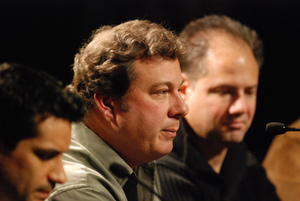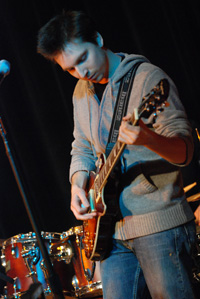64-Bit Symphonies

Tommy Tallarico, Clint Bajakian, and Gerard Marino speak at a Berklee clinic.
Photo by Phil Farnsworth

Video Game Music Club president Filippo Beck Peccoz
Photo by Phil Farnsworth
It's a field that may be overlooked in favor of its big brother, the film industry, but the video game market has definitely come into its own, with software sales of more than $9.5 billion in 2007. Making music for these games is big business, and Berklee students are ready to dive into it.
Composers Tommy Tallarico, Clint Bajakian, and Gerard Marino came to Berklee recently to share advice for surviving in the burgeoning field of video game audio. Their panel discussion was followed by a performance by Berklee's recently formed Video Game Music Club, whose membership has climbed to 85 since its September inception.
Members of the club also played at the Game Audio Network Guild (GANG) Awards the week before, rubbing elbows with GANG cofounder Tallarico, who's worked on titles such as Prince of Persia and Tony Hawk Pro Skater; BioShock composer Garry Schyman; God of Warcomposers Marino and Mike Reagan; and Bajakian, who while at LucasArts worked on various Star Wars and Indiana Jones titles.
"Performing at the GANG Awards was a dream come true," said Filippo Beck Peccoz, president of the Video Game Music Club. "Imagine being in the same room as [film composers] Hans Zimmer, John Williams, and Thomas Newman, and being able to talk with them. This is what happened at the awards—only in the field of game audio."
The growing interest in video game music has also gained the attention and support of Berklee's Film Scoring Department, which is presenting a new Music for Video Games weekend summer program in 2008.
The following are excerpts from the panel discussion.
Tallarico on networking:
"Talent is just 50 percent of the job. The other half is networking and being able to sell yourself. . . . Just sending a demo tape off to someone means nothing. But meeting someone in person and having the ability to sell yourself means everything."
Tallarico on audio engines:
"Everybody has their own tool sets. But I think the universal is Sound Forge, in terms of editing files. It's like an artist learning Photoshop. But each platform has its own audio engine. Sony's is called the SCREAM engine. On the XBOX it's called XACT. On the PC there's a a Miles driver. . . . You don't have to know all that stuff, but it's definitely to your advantage to understand what the systems are capable of."
Marino on recording for games:
"We did a full orchestral thing for God of War 2. . . . In order to build in some interactivity, you really need to record the sections separately. It's less likely that you're going to have a whole orchestra sitting there in the same room in the true Hollywood grand tradition. If they're going to shell out the dough for a big orchestra, they're going to want to get the most mileage out of it."
Marino on networking at college:
"You might land a job and find yourself totally behind an eight ball without enough money to hire someone. Your buddies that you make here will do it for a pizza and get you through the day."
Bajakian on attitude:
"There are two different ways that folks will approach me when they're looking for work, especially younger folks, less experienced folks. . . . One is 'Let me tell you about myself,' and the other is 'What are you guys doing and how can I help?' Everyone who's working is absolutely up against the wall and needs the help."
Bajakian on timing:
"How do you make a score for a video game adapt to game play, when you're not sure the timing of events as they unfold? You know the monster is going to come out of the cave at some point and you know the music that you're going to have playing when this happens, but you don't know where you are going to be in several pieces of music that are tiling and shuffling against each other in some sort of scripted way that keeps the music fresh. One of the axioms I always use is you don't know where you're coming from, but you know where you're going. Once that transition happens, it's like a train switch, now the music goes off and it does something that you're in total control over. You've worked it all out."
Bajakian on layering:
"Musical interactivity can be understood in two main planes: a vertical plane and a horizontal plane. In the horizontal domain, we think of it as branching. You're in a piece of music, something happens, it cross fades to a transition piece, and then another piece of music. . . . It may not even be on a beat."
"In the vertical domain you can break the music up into layers. Think of a multichannel piece of music where the bottom layer is relaxed strings and synth, just kind of eerie. The next layer some light skin percussion comes in, maybe some reverb—it just brings up the sense of excitement a little. The next layer, the percussion really starts coming in. And then in the final layer, you have all the other elements, shakuhachi overblows, the piece of music is at its full tilt. All four of those stream off the disc in real time and the layers get brought in along with the expansion and contraction of the level of action in the game."
"How do you know you're not going to turn up the top layer in the middle of a big soaring melody? That's the largest challenge that we face—that the edit isn't going to sound smooth and musical when it happens. Those two pitfalls are what we spend greater than 50 percent of our time attending to. . . . What distinguishes the art from the crap in video game music is the adaptability."
